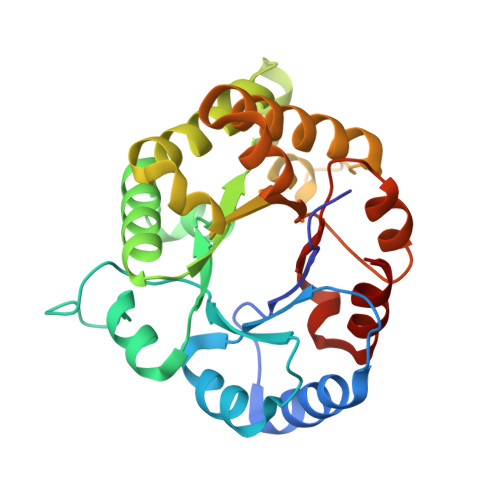Different contribution of conserved amino acids to the global properties of triosephosphate isomerases.
Aguirre, Y., Cabrera, N., Aguirre, B., Perez-Montfort, R., Hernandez-Santoyo, A., Reyes-Vivas, H., Enriquez-Flores, S., de Gomez-Puyou, M.T., Gomez-Puyou, A., Sanchez-Ruiz, J.M., Costas, M.(2014) Proteins 82: 323-335
- PubMed: 23966267
- DOI: https://doi.org/10.1002/prot.24398
- Primary Citation of Related Structures:
4HHP, 4JEQ - PubMed Abstract:
It is generally assumed that the amino acids that exist in all homologous enzymes correspond to residues that participate in catalysis, or that are essential for folding and stability. Although this holds for catalytic residues, the function of conserved noncatalytic residues is not clear. It is not known if such residues are of equal importance and have the same role in different homologous enzymes. In humans, the E104D mutation in triosephosphate isomerase (TIM) is the most frequent mutation in the autosomal diseases named "TPI deficiencies." We explored if the E104D mutation has the same impact in TIMs from four different organisms (Homo sapiens, Giardia lamblia, Trypanosoma cruzi, and T. brucei). The catalytic properties were not significantly affected by the mutation, but it affected the rate and extent of formation of active dimers from unfolded monomers differently. Scanning calorimetry experiments indicated that the mutation was in all cases destabilizing, but the mutation effect on rates of irreversible denaturation and transition-state energetics were drastically dependent on the TIM background. For instance, the E104D mutation produce changes in activation energy ranging from 430 kJ mol(-1) in HsTIM to -78 kJ mol(-1) in TcTIM. Thus, in TIM the role of a conserved noncatalytic residue is drastically dependent on its molecular background. Accordingly, it would seem that because each protein has a particular sequence, and a distinctive set of amino acid interactions, it should be regarded as a unique entity that has evolved for function and stability in the organisms to which it belongs.
Organizational Affiliation:
Departamento de Bioquímica y Biología Estructural, Instituto de Fisiología Celular, Universidad Nacional Autónoma de México, México D.F, México.
















